Surinamese Rainforest
The Surinamese Rainforest region comprises Suriname's three inland administrative districts: Brokopondo, Para and Sipaliwini. The area is part of the vast Amazon region and is almost entirely covered with tropical rainforest. In the southwest is the Sipaliwini savanna area. In the centre and south are mountain ranges. The highest peak is Julianatop at 1280 m. Most Amerindians and Maroons live in this region, many of them in a primitive way. Lake Brokopondo, with an area of 1,560 km², is one of the largest reservoirs in the world.
.png)
Get in
The Brokopondo and Para districts can be reached by 4x4s. Sipaliwini, especially the central and southern part, is best reached by air. Airstrips are scattered around and these are regular served from Zorg en Hoop Airport in Paramaribo.
Check with Blue Wing Airlines, Caricom Airways and Gum Air for flights to the inland airstrips, but do compare to organized tours, as individual air travel is not always cheaper, especially when you're headed for one of the larger resorts.
To a certain point, there are roads and you'll be able to drive. Make sure you have a reliable 4x4 however, and ideally have several people in the car. Road conditions are poor in some of these areas and especially after rain, getting stuck is not uncommon. Even tour operators sometimes need their guests to help them push the car out of the soaking dirt.
It should in theory be possible to buy a boat in one of the larger river towns in the coastal areas, but the process will probably take more time and money than you might hope. Also, Suriname's rivers have many rapids and travelling down them on your own is a considerably risky undertaking.
Get around
Most people visit Suriname's inland destinations as part of an organized tour. In such cases, all transport will be arranged for you, often including boat trips and 4x4 road tours.
Individual travel is increasingly possible along the rivers, as villages discover the financial benefits of receiving guests. Some stretches can be explored individually (using public transport and chartered boats) without too much effort, including the trip to Pokigron and along the river from there. Once at your destination you will be handed over to the local transport options - and those are usually quite limited. Often you will only be able to move on foot or by boat. Boat taxis run irregularly between some villages. Never forget where you are however: the jungle is wide and far. Even for shorter hikes into the forest to find a water fall or other sight it's advisable to hire a guide.
Making your way around the more remote Amazon jungle on your own is not impossible, but it sure is challenging and not without risks, and thus should only be done with ample preparation and experience. Note that distances between settlements can be huge, with no organized transport in between. Bring your own hammock. When there's no facility to stay, villagers will usually be okay with you hanging it somewhere in the settlement.
Towns
Apoera
This village lies in the Sipaliwini district near the border of Nickerie district and Guyana. It is reachable by boat on the Corentyne River 120km south of Nieuw Nickerie, or by car from Paramaribo over 350km mainly dirt road. Washabo airstrip is reachable from Paramaribo Zorg en Hoop in one hour.
Once it was intended to build a seaport here. This is never realized. Today there live about 3000 people, mainly Arawak Indians. It is a nice place to make boat trips over the Corentyne River and to visit Arawak Indians in Washabo. At high tide a boat trip to the falls of Blanche Marie can be arranged. These falls are reachable by car about 50km from Apoera.
- Riverside Resort (On the road from Apoera to Washabo), ☎ +597 8764896. A nice place on the banks of the Corentyne River. You will sleep in a hammocks. There are 20 hammocks available in pina cabins. Groups get discount. SRD75 p.p..
Brokopondo
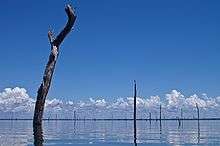
Brokopondo is a capital town of the Brokopondo district. It is located on the west shore of the Suriname river, just north of the Afobaka dam. The village can be reached via the road from Paranam to Afobaka. There's a large beach on the Suriname river near the city centre. In Brokopondo you can arrange boat trips on the lake and to several islands where some have facilities to sleep.
Lake Brokopondo, official name Prof. Dr. Ir. W.J. van Blommesteinmeer, is a reservoir that was created after the construction of the Afobakadam in 1964. With an area of 135 thousand hectares it is among the largest reservoirs in the world. Bare treetops still protrude above the water surface. The former hill tops have become islands and nowadays these are tourist destinations.
- Libi da Wai Island, ☎ +597 426356. Libi da Wai Island is a beautiful coconut island. The boat trip to the island takes one hour. It has an area of 7 acres and it is uninhabited. It has a camp with hammocks and there are plans to build a couple of houses with beds. It has a sand beach and you can make a forest walk. €150 p.p. for 2 nights inclusive transfer from/to Paramaribo, food and non-alcoholic drinks.
- Tonka Island, ☎ +597 8604741, e-mail: soestroon@hotmail.com. Tonka island covers an area of 100 acres. There are 4 big houses with beds for 13 until 40 people. €150 for a F-Su inclusive weekend, transfer from/to Paramaribo, food, drinks and guided walks..
Kwamalasamutu
Tucked away deep in the Amazon jungle, in Suriname's far south-west, this rather large Indian village is home to about 1000 people from some 10 different tribes. It's still pretty off the beaten track for now, but except for its remote location, this place has what it takes to become one the country's main tourist draws. Apart from its wonderful indigenous culture and beautiful surroundings, this place boasts grottoes with 5000 year old rock engravings. Only discovered by modern science in the year 2000, there's still much to be learned about the history of these Werehpai grottoes but it's obvious that they are a major Amazon attraction. With help of Paramaribo based tour operators, the small and community owned Iwaaana Saamu Rainforest Lodge has been built close to the grottoes, about 20 minutes by boat from Kwamalasamutu itself. Unfortunately, getting and staying here does not come cheap. You'll have to resort to an organised tour, which is usually 4 days and typically costs around €1,200, including the 2 hour flight from the capital. For that, however, you will get an experience you will not forget, including substantial insights in the traditional village life (including a meeting with the shaman and music night) and of course the usual canoe trips over the Sipaliwini river and such.
Pokigron
Pokigron (also known as Atjoni) is a village in the heart of Suriname, inhabited by approximately 500 Maroons. The village is situated on the left bank of the Upper Suriname River, just southwest of the Brokopondo reservoir. It is the last village that can be reached by road from Paramaribo and the embarkation point to travel to the villages along the Upper-Suriname River.
Other destinations
Brownsberg Nature Park
This park is situated 130 km (90 mi) south of Paramaribo, and can easily be reached by car. The park headquarters and tourist bungalow/lodges are situated on the cool, 500 m (1,500 ft) high Mazaroni Plateau. At several places on the plateau there is a beautiful view over the Brokopondo Reservoir. Trails lead to creeks, waterfalls and lookouts, giving spectacular panoramic views of the interior. Except for the park staff, there is no permanent habitation in the park itself. The Brownsberg is known for its rich flora and fauna. It is also a paradise for birdwatchers. Of the 650 birds known for Suriname, more than 200 can be found here. Some of the birds are rarely seen because they live in the forest canopy, although their songs and whistling are heard regularly.
Unfortunately there is a decline in visitors because of the dramatic damage that is caused by gold mining.
There are several hiking trails:
- Ireneval - Length 4km. Irenevallen is a waterfall of about 10 m high in the Brownskreek. It is about an hour's walk from park headquarters. You should have a fairly good condition to make this walk. After a heavy rain it is wonderful to stand under the natural shower of the waterfall.
- Koemboeval - Length 4.5km.
- Leoval - Length 1.5km.
- Mazaronitop - Length 5.5km.
- Plateau rondwandeling - Length 3km.
- Witikreek - Length 8km. Witikreek is a secluded rushing stream at the foot of the Brownsberg. You can walk to it in about a two-hour downhill hike. Once there you can swim, nap in a hammock, and have a picnic.
Central Suriname Nature Reserve
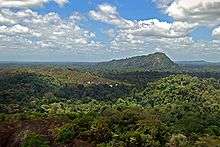
The UNESCO World Heritage listed site "Central Suriname Nature Reserve" (CSNR) protects some of the most remote, ancient, and pristine wilderness on Earth. It comprises more than 1.6 million hectares of primary tropical forest. The Reserve forms a corridor linking the three most important protected areas in central Suriname: the Raleighvallen Nature reserve in the north, and the Tafelberg and Eilerts de Hann Gebergte Nature Reserves in the central and southern portion of the corridor. The area — the size of New Jersey— protects the watershed of one of Suriname's most important river systems, the Coppename River, where there are countless varieties of flora and fauna, many of them endemic. The Raleighvallen Nature Reserve is one of the most important protected areas in South America. Vegetation there consists mostly of moist highland forest, the same forest that covers approximately 80 percent of Suriname. The Tafelberg Nature Reserve is in a remote area that includes the geographic centre of Suriname and is primarily rainforest and savanna ecosystems. The Eilerts de Hann Gebergte Nature Reserve has no human populations living within or around its boundaries. This reserve includes parts of the Eilerts de Hann Gebergte mountain range and is made up of primary tropical rain forest and savannah ecosystems. Since there has been very little exploration in this Reserve, little is known about it's flora and fauna. The Central Suriname Nature Reserve is an important precedent in protecting large blocks of undisturbed tropical wilderness. But it is only a first step. The challenge for Conservation International and its funding partners is to continue these efforts to protect the ecological viability of the world's last remaining tropical wilderness areas. Conservation International has been active in Suriname since 1991, using an integrated approach that draws on both the knowledge and expertise of highly trained Surinamese conservationists as well as CI's on-the-ground experience in twenty-two other countries of the world.
Rather than sell the country's forests to the highest-bidding timber companies, the Surinamese government made a commitment in 1998 to protect the forests and explore the long-term economic benefits of sustainable development and ecotourism. Conservation International (CI) joined Suriname to help design, fund, and promote this effort to carefully blend biodiversity conservation and economic opportunity.
Seven years later, the uniquely constructed tourist facilities on Foengoe Island—tucked neatly within the CSNR—are poised to become a premier destination for ecotourism in the Guiana Shield, the massive, two billion-year-old geological formation that underlies five countries in northeastern South America.
Colakreek
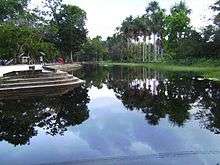
Somewhat identical to the Suriname River resorts White Beach and Overbridge is Colakreek. Located in the midst of the savannah and surrounded by forests, the waters here are coloured dark brown by tannins leached from fallen leaves. The resemblance with the world's most popular soft drink is obvious, hence the site's name. The water is perfectly safe for swimming however, as the process of falling leaves keeps the acidity of the water more or less constant. There are some options to stay overnight, but Colakreek is also a popular day trip destination for tourists and Surinamese alike. It's become a fairly well-developed recreation park with a cafeteria, some playgrounds and options to rent open huts, parasols and water bikes. When you've had enough of the swimming and sunbathing, the surrounding woodlands offer some nice, shady hiking options. There are several indicated routes to follow, some suited for children too. There's also a small savannah education centre in the park, with information on the area's history, flora and fauna.
The park is just a 5 minute drive from the Johan Adolf Pengel International Airport. Although extensively renovated in the mid 1990s, Colakreek has been developed as a recreation area since World War II, when American soldiers came here to relax and for a swim. It's now exploited by Mets. Weekends and holidays bring in some crowds from Paramaribo, but even then it's a fun place to spend a day, especially if you're travelling with children.
- 🌍 Colakreek Recreatiepark (3km west of the Johan Adolf Pengel International Airport). Adults: SRD12.50/15 on weekdays/weekends, children SRD6.50/7.50. Camping spot SDR20, camping hut SRD95. Four person holiday houses with kitchen and bathroom from SRD295 per night..
Jodensavanne
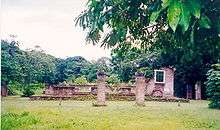
This now ruined, historic settlement of Sephardic Jews is located about 50km from Paramaribo and considered one of the main cultural heritage sights in Suriname. With no other major destinations around, it's typically visited as a day trip from the capital. After the first Jews settled here in 1650, the settlement flourished. There were sugar refineries around the village and a vibrant town life developed revolving around the synagogue. As Paramaribo developed, most of the inhabitants moved away, returning only for celebrations by the end of the 18th century. Largely burned to ashes in 1832, the place became uninhabited, although the synagogue remained in use until around 1860. After that, Jodensavanne was repeatedly overgrown and recovered from the jungle, until the final restoration of the ruined site in the 1970s. It's now run by the Jodensavanne Foundation. It's not a large site and, therefore, often combined with a trip to an Amerindian village or the Blacka Watra recreation park, a popular place to swim and famous for its naturally black water. Before you plan to go to Blacka Watra, check if the park is reopened as it was closed in 2013 due to a violation of environmental laws. There's no public transport so unless you have your own transport, you'll have to arrange a tour. Almost any tour operator or hotel can arrange it for you, with listed prices often around €85 including lunch and a stop in a remote village. Bargaining and shopping around will get you the same for less, however, especially in low-season.
|
Carolina bridge  |
Nature Resort Kabalebo
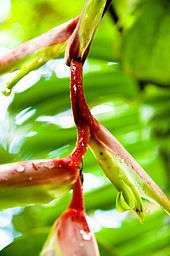
Kabalebo Nature Resort lies in the unspoiled west of Suriname. This area is completely uninhabited, allowing one to rightfully speak of "untouched nature". Within a circumference of hundreds of kilometres, you will see nothing except for the flora and fauna of the splendid Amazon rain forest. Where playful monkeys leap through the treetops, the colourful parrots glide above your head and unusual fish leap and quickly swim away down a secluded creek...
Besides the numerous unusual birds, colourful butterflies and many dazzling types of fish, you may also come across a member of the cat family, the jaguar. You may spend hours on exploratory trips together with your guide. But you may also see many animals even if you decide to remain in the vicinity of the lodge.
- Kabalebo Nature Resort, Van Idsingastreet 68, Paramaribo, ☎ +597 426532. Any tour operator will book your trip at Kabalebo Nature Resort in Paramaribo or you can do it yourself as well. Compose your own tour in consultations. You can stay from 3 to 9 days. In Kabalebo are four accommodations from basic to luxury. If you like you can sleep in a hammock at the riverside in a camp about 15 minutes away by boat from the main lodge. Note that you cannot use your cell phone in the resort. Communication can only be done by employees by radio.
Palemeu
Hidden deep in the Amazon jungle, the traditional way of getting to the Amerindian village Palumeu would require you to spend 10 days or so on a river boat from Albina. For those who can't allow that kind of time, it's about a one hour flight from Paramaribo. Logging and fishing are the main activities of the 200 or so Indian inhabitants, who mostly belong to the Tiriyó people. However, this laid-back village along the river Tapanahoni is discovering its options as a sustainable tourism destination. There are no direct reservations and you'll have to come here with an organised tour, usually 3 to 5 days, but it is one of the best Suriname jungle experiences to be had. Visitors stay in a pleasant lodge just outside the Indian camp, with excellent food. Several tour operators have the trip in their portfolio. They'll fill your days with guided medicinal tours through the rain forest, fishing piranhas from a canoe and getting your adrenaline up while struggling to get your boat through one of the many cascades around. Hike up Poti Hill for some excellent views over the area, wake up to an orchestra of birds in the morning and hike out to a waterfall for a bath.
- Kasikasima - For adventurous people in good physical condition a five-day canoe trip to Kasikasima is highly recommended. Kasikasima is a mountain range that can be reached upstream of the Palumeu River in two days. On the go you will stay in an encampment and sleep in a hammock under a shed. To Kasikasima you pass the Trombaka-sula rapids. These are not navigable and you'll have to climb around. Another boat is waiting for you to continue your excursion. From the base camp where you stay 2 nights you can walk to one of the Kasikasima tops: a steep climb of 2.5 hours. From there you have a wonderful panoramic view and can even see Brazil, 75km ahead.
Raleighvallen Nature Reserve
This nature reserve has an area of 78,170ha and is situated along the Coppename River. It can be reached by aircraft (less than an hour) or by car (120 mi) to be followed by a 3-4 hour boat ride. The reserve headquarters and the tourist lodges are located on Fungo Island in the middle of the Coppename River.
Raleighvallen (Raleigh Falls) is the name for the extensive set of rapids near Fungo Island in the upper Coppename River.
The reserve is internationally known as a bird and monkey paradise. You'll see toucans, macaws and parrots and 400 other species. Hanging from the tree branches on and around Fungo Island you'll notice the pendulum-shaped nests of the weaver birds (oropendulas) which are large, colonial nesting birds with yellow outer feathers. These nests can be close to a meter long.
Another interesting feature is the Voltzberg. This granite sugarloaf mountain can be reached on foot in about three hours by jungle trail from Foengoe Island. The Voltzberg rises about 150 m (375 ft) above the forest canopy. The night can be spent in a hammock in a simple jungle camp at the base of the mountain. During the night you will be surrounded by the sounds of monkeys, tree frogs, and other creatures from the tropical rainforest.
The reserve is also the home of the spectacular and rare cock-of-the-rock (Rupicola rupicola).
There is the possibility, as well, of encountering deer, tortoises, tinamous, and several species of monkey on the 7km (one-way) hike to the mountain. The trail is good but the damp climate of the rainforest, and the steep climb up the Volzberg, make it a heavy trip, especially for the out-of-shape hiker.
River resorts
The Suriname River side is not very suitable for recreational swimming. In order to make this possible sand has been spread on the bank in different places along the river, such as White Beach and Over Bridge, which are not far from Paramaribo. These places have become very popular and are crowded in the weekends. To protect swimmers from piranhas nets are drawn. Over the years both places are further developed and have become restaurants and overnight accommodation. There are hammocks, beach chairs and umbrellas available. For children play facilities are constructed. You can rent kayaks and fishing gear.
- 🌍 Overbridge River Resort (From Jules Wijdenbosch bridge go south over Martin Luther Kingweg for about 38km, turn left for 8km.), ☎ +597 8886604, e-mail: overbridge@sr.net.
- 🌍 White Beach (From Jules Wijdenbosch bridge go south over Martin Luther Kingweg for about 25km, turn left for 4km.), ☎ +597 6808001, e-mail: info@whitebeachsuriname.com.
Upper Suriname

The Suriname River is fed by two source rivers, the Gran Rio and the Pikin Rio which rise in the Eilerts de Haan Mountains. Near Djumu, about 100km south of Lake Brokopondo, these rivers flow into the main stream of the Suriname River. This is the Upper Suriname region, home of about 15,000 Saramaccan Maroons. The Maroons are descendants of runaway slaves that fled into the forests of Suriname already from the second half of the 17th century. Because of their isolated habitat they have retained much of their original African life style. This, their easy rapprochement and the overwhelming nature, makes it a fascinating destination.
Just 20km south of Lake Brokopondo is Pokigron which is the last place that can be reached by car. This place is also known as Atjoni. Most tourists come here (organized as well as individual) by mini bus from Paramaribo which is about a 4 to 5 hours 180km ride over mainly dirt road. Mini buses leave in Paramaribo every day except on Sunday from Saramaccastraat 07:00-08:00. Price is SRD80.
From Atjoni further south to Kajana, a distance of about 100km, are a lot of villages with all kind of accommodations to stay for one or more days. Boats leave from Atjoni river bank. Go there and ask around. You don’t have to plan your trip before and just go by good luck, look around, ask, negotiate. This is the cheapest way to travel. The price depends on where you’re heading for and the choice of your boat. There are taxi boats and line boats. Roughly estimated it will be about €10 per hour (20km) sailing.
A fast way to travel to Kajana or Botopassi is by air.
- Blue Wing Airlines, Airport Zorg en Hoop, Paramaribo, ☎ +597 434393, e-mail: sales@bluewingairlines.com. M,W,F 11:00. Be present at 10:00. On Friday and Monday, Awarradam group travellers leave and return. €124/€224 single/return.
You can find dozens of accommodations along the riverbank from Atjoni to Awarradam. Five accommodations more or less randomly chosen from north to south:
- 🌍 Lobi Lafu Camp, Atjoni, ☎ +597 8898 827, +597 8180 752, +597 8509 834, e-mail: info@lobilafu.com. Lobi Lafu – “love laughing” – is located just north of Atjoni at the Apresina Sula. It has 5 jungle huts with 20 beds and 30 places in hammock camps. The adventure team of Lobi Lafu offers multiple jungle activities like the canopy Zip Line, abseiling, rafting and hiking to the nearby Marron villages. SRD50 p.p.p.n..
- 🌍 Danpaati River Lodge, Danpaati, ☎ +597 471113, e-mail: reservations@danpaati.com. Danpaati River Lodge is one of the most luxurious and comfortable lodges along the river and offers a pool and yoga-deck. The price is inclusiding transportation (boat/bus), meals and guided tours. The lodge collaborates closely with the surrounding villages by investing in social projects and therefore your visit is social sustainable. In the area of the lodge the villages the Maroon culture is most intact and they are happy to welcome you! €335 p.p. for 3 days (2 nights).
- 🌍 Hotel Botopassi, Botopassi, ☎ +597 8659702, e-mail: corry-vonk@hotmail.com. 9 rooms and 6 cottages. A place to relax in a beautiful environment. €35 p.p.p.n..
- 🌍 Pingpe, Pempe, ☎ +597 8768014, e-mail: info@jungleresortpingpe.com. Pingpe has 4 cottages for 3-5 persons. The price is inclusive flight to Djumu, meals and guided tours. €285 p.p. for 3 days (2 nights).
- 🌍 Kosindo River Lodge, Kajana, ☎ +597 8841273, e-mail: kosindoriverlodge@gmail.com. Kosindo is located just at the lively jetty of Kajana village. It has 5 cottages for 2 persons and a family cottage for 4 persons. €37 p.p.p.n..
- 🌍 Awarradam Jungle Lodge & Spa, Awarradam, ☎ +597 472621, e-mail: mets@sr.net. Awarradam is a small island in the Gran River. The resort is setup by the government and managed by METS. It had 14 cottages for 2 or 3 persons. All have a terrace with hammocks overlooking the river. Transport, food, drinks (coffee, tea and juices) and guided tours are included. Most employees are local people and live in the employee-village across the river. The organization is set to receive groups. If cottages are vacant individual travelers are welcome. €535 p.p. for 4 or 5 days (3/4 nights).
Do

Depending on where you stay, all kind of activities and guided tours can be arranged:
- Picnic and/or swimming in river rapids (sulas), river resorts or lakes
- Jungle treks (for a couple of hours or multiday)
- Nightly caiman tour
- Vistiting kostgrondjes (the Maroon way agricultural plots)
- Visiting Maroon and Amerindian villages and see traditional dances
- Birdwatching from the river
- Kayaking
Buy
The deeper into the forest you go, the fewer traditional commodities are available. If you travel by organised tour, everything will usually be arranged for you. If you're travelling on your own, however, stack up well before you go. Villagers do offer all kinds of self made products: like woodcarvings, embroidered doilies, painted calabash drinking cups and flutes, which make for excellent souvenirs while supporting the local culture.
Stay safe
General anti-mosquito measures are advised, to prevent risks of both malaria and dengue. In this part of Suriname malaria occurs, although it was last reported in 2005. However, it is advisable to use malaria pills. Malaria mosquitoes bite mainly in the evening, at night and in the early morning. Dengue mosquitoes bite also during the day. Risks are reduced by wearing long sleeves and trousers. An insect repellent containing DEET is recommended, as well as the use of a mosquito net at night. Lodges where mosquitoes are common often (but not always) have mosquito nets available, but especially when travelling individually, bring your own. In case of fever during or after a stay always visit a doctor within 24 hours and don't use ibuprofen based pain killers: paracetamol is okay.
The water level and the force of the flow depend on the season. Since you will often be transported by boat wearing of a life jacket is recommended.
Go next
Once you're buried deep in the Amazon jungle, anywhere you go next is a pretty far way to go. Head back to civilisation in lively Paramaribo or try a different kind of rural Suriname at the plantations of the East Coast. That's also the place to see that other grand natural sight the country has to offer: the nesting sea turtles near Galibi. Go bird watching in the vast mangrove forests of the West Coast or, if you're close to the border rivers, hop over on a small boat. The river side villages on the other sides, in Guyana and French Guiana, have stories of their own to tell.